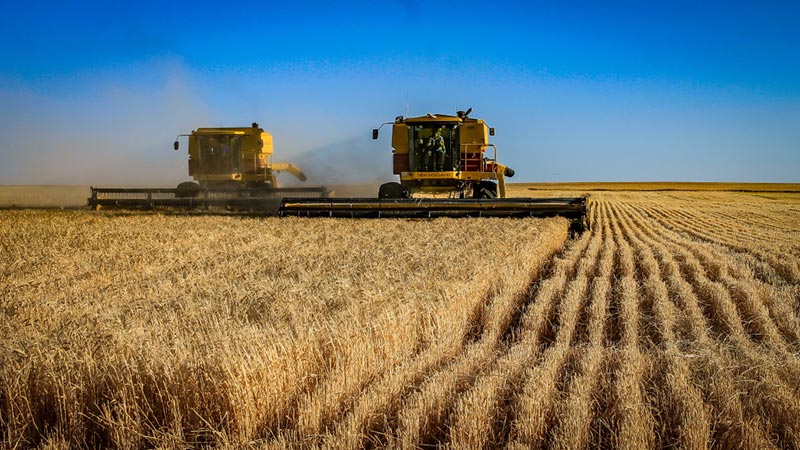Could crop waste be farming’s Aladdin’s cave?
By Professor Amanda Ellis, Head of Department of Chemical Engineering
Turning waste into a resource will be fundamental to building more sustainable economies, but to do this we need science, and we need industry to be aware of the potential materials that can be generated from waste.

One of the more prospective areas we’re investigating at the University of Melbourne is crop waste – the vast tonnages of stalks, leaves, roots, seed pods and other plant material left after fruits and grains have been harvested and processed.
At the molecular level this material represents a potentially significant and currently unrecognised treasure trove of biochemicals, minerals and structural materials such as lignin and cellulose. Some estimates suggest crop residues represent 60 to 90 per cent of agricultural biomass.
This offers an enormous untapped resource that we can repurpose, and in doing so give it a clear economic value.
At the molecular level, agricultural biomass from different plants and different parts of plants possesses many unique chemical, structural and mechanical properties that science and industry can exploit. Our understanding of the science and how compounds can be refabricated at the molecular level to create new materials is constantly evolving.
At the molecular level, agricultural biomass from different plants and different parts of plants possesses many unique chemical, structural and mechanical properties that science and industry can exploit
We already have expertise in nanocellulose extraction, and we are expanding into nanofibres and nanocrystals, which can be used as membrane materials or in applications such as hydrogel wound treatments or binding agents in food manufacturing. Certain crop-waste materials are also being developed for use in particleboard in the housing and construction industry.
Traditionally, crop waste has simply been composted or burned. Both of these practices contribute to greenhouse gas emissions and land contamination. That’s a major reason why we should rethink how agriculture manages its waste.
In recent years some countries have also started using crop waste as a feedstock for biofuels. But as nanotechnologists and chemical engineers, we think there are more exciting opportunities; that’s why we’re building a dedicated research hub at the University of Melbourne.
This will allow us to work collectively and will open the way to bespoke applications or new uses for crop waste, as well as lifting the function and value of existing products.
For example, biochar has emerged as an effective soil ameliorant for many Australian soils that are deficient in organic carbon. Biochar is derived from biomass using pyrolysis – the process of decomposing plant material using heat. It’s a stable form of organic carbon and has been of increasing interest to Australian farmers.

Decomposing plant material can be turned into biochar, an effective soil ameliorant | Photo by Oregon Department of Forestry / CC BY 2.0
But if the pyrolysis is done a certain way, it makes the biochar porous and creates a medium that could be impregnated with slow-release nutrients. This would give biochar an enhanced role and value as both a soil ameliorant and a slow-release fertiliser mechanism. This would have clear benefits for areas where excess nutrients create problems through run-off or leaching into adjacent ecosystems, such as the Great Barrier Reef catchment.
Pyrolysis can also be used to transform plant waste into a form of graphene. This opens the door to uses in electrodes, including flow electrodes, which are showing early promise as a more efficient, large-scale water treatment and desalination technology.
Our work to transform crop waste into useable materials or products fits within the growing worldwide notion of the ‘bioeconomy’ – the move to more sustainably managed biological resources by better defining their value.
For me, it’s also part of a vision for the total agro-cycle efficiency of all resources. When you consider how much water, energy and human power that goes into producing crops and then consider how much biomass is not used afterwards, it clearly is a massive opportunity to be exploited.
Our work to transform crop waste into useable materials or products fits within the growing worldwide notion of the ‘bioeconomy’ – the move to more sustainably managed biological resources by better defining their value
So our objective is to create an economic value for biological resources, such as crop waste, to encourage its development into a secondary product stream either on-farm or coming off-farm.
And this is where science, engineering and industry will need to dovetail. Individual farmers are unlikely to have the capacity or scale to create product from their crop waste, so there needs to be a district or regional buyer of this material.
You don’t want to be transporting this material large distances because that would negate its value. So its transformation needs to be local and needs to match a particular end product with the type of biomass available. For example, vineyards or pineapple fields would offer different types of biomass with intrinsically different molecular properties.
Science and engineering can create exciting uses for crop waste, and we also have a generation of young farmers who are both entrepreneurial and sensitive to their environment. They are very conscious of these big agro-cycle issues and are looking for ways to ‘give back’ to the farms and land that sustain them.
This is the kind of philosophy and economics we need to secure a more sustainable use of agricultural resources, particularly land and water resources that are already under pressure around the world.
Related topics